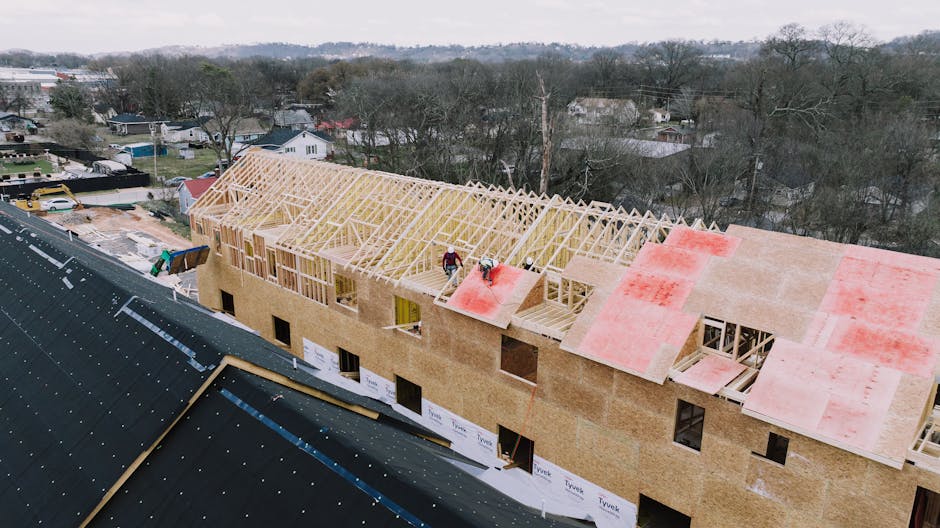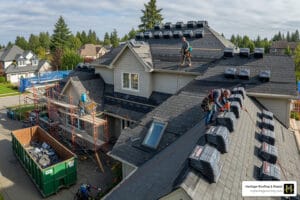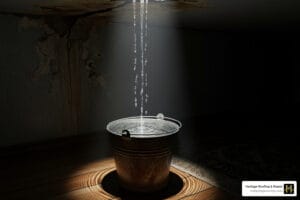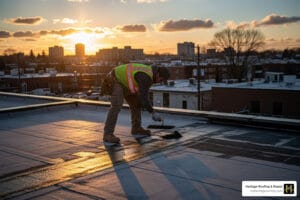Arkansas Roofing Requirements: What Every Homeowner Needs to Know for a New Roof
New residential roofing involves more than simply selecting attractive materials. It requires a deep understanding of local building codes, climate considerations, and structural requirements to ensure your investment protects your home for decades. Whether you’re building a new home or replacing an aging roof, partnering with professional roofing contractors in Northwest Arkansas is the first step toward guaranteeing safety, durability, and compliance. Meeting these standards is not just about following rules; it’s about securing your home against Arkansas’s unique weather challenges and ensuring your new roof lasts.
Key Requirements for New Residential Roofing:
- Building permits and code compliance – Required for most roofing projects
- Structural load calculations – Ensuring your roof can support the chosen material weight
- Wind resistance ratings – Critical in storm-prone Arkansas
- Fire resistance classifications – Meeting local safety standards
- Proper ventilation systems – Preventing moisture and energy inefficiency
- Professional installation – Ensuring warranty coverage and code compliance
The roofing industry has evolved significantly, with new materials offering longer lifespans and better performance. Traditional asphalt shingles now last 15-30 years, while metal roofing can exceed 50 years with proper installation and maintenance. Modern composite shingles provide 40-50 year lifespans, and well-maintained slate roofs can last over 100 years.
Arkansas homeowners face unique challenges including severe weather, high humidity, and potential hail damage. A quality roof installation must address these climate factors while meeting local building standards.
As Rex Wisdom, owner of Heritage Roofing & Repair with over 50 years of family experience in the roofing industry, I’ve guided countless homeowners through new residential roofing projects throughout Northwest Arkansas. My expertise spans everything from material selection to navigating local building codes, ensuring each project meets both regulatory requirements and long-term performance expectations.
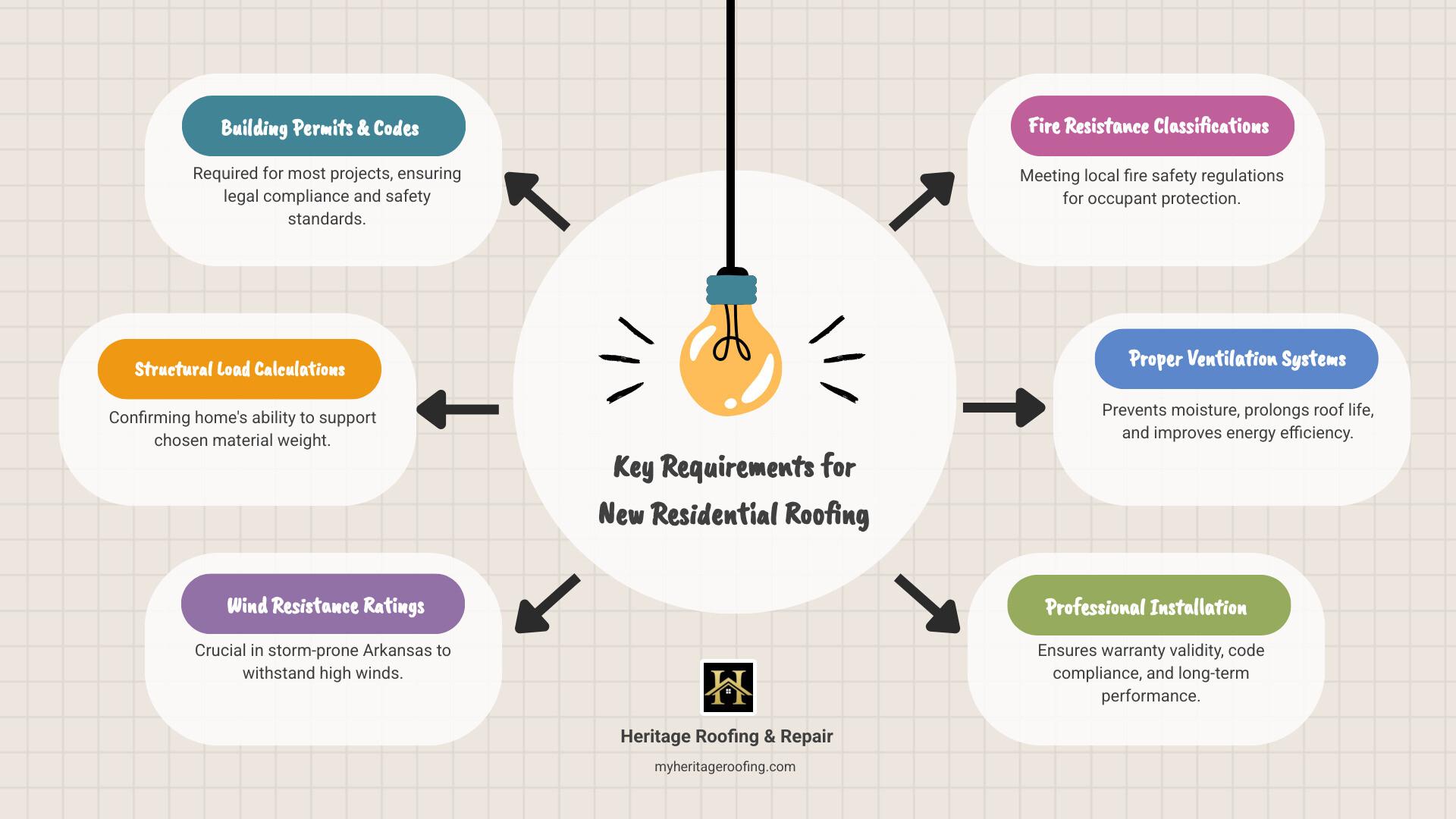
Key Considerations for a New Roof in Arkansas: Climate, Codes, and Structure
When starting on a new residential roofing project in Arkansas, understanding the unique environmental and regulatory landscape is paramount. Our state’s climate brings specific challenges, and local building codes ensure your home is built to withstand them. We also need to consider the structural integrity of your home to support your chosen roofing material.
Arkansas is no stranger to severe weather, with heavy rain, high winds, and hail being common occurrences. These factors are why we emphasize materials that offer superior durability and resistance. Beyond just the weather, other elements like roof pitch, the structural load your home can bear, and proper ventilation play crucial roles in your roof’s longevity and performance. Features like dormers can add architectural beauty but also introduce complexities that require extra attention to ensure water-tightness. For homes that have suffered from the wrath of nature, our team is always ready to assist with storm damage roof repair.
Understanding Local Climate Impact
Arkansas homeowners live in a region that experiences a wide range of weather conditions. Our hot, humid summers mean intense UV ray exposure, which can degrade certain roofing materials over time. This makes energy efficiency a significant consideration; materials that reflect sunlight can help lower cooling costs. Metal roofing, for instance, has been shown to reduce cooling costs by up to 25% due to its reflective properties.
Then there’s tornado season, which brings the potential for extreme wind uplift and impact from debris. The frequency of hail in many parts of Arkansas makes impact resistance a non-negotiable feature for many homeowners. Fiberglass asphalt shingles, for example, are known for standing up to harsh wind and hail. Beyond the immediate threats, our humid climate also fosters algae and mildew growth, which can mar the appearance and potentially shorten the lifespan of some roofing materials, particularly fiberglass asphalt shingles. While less common, northern Arkansas can also experience snow and ice, requiring considerations for proper insulation and snow shedding.
Navigating Building Codes and Structural Requirements
Before any new residential roofing project begins, navigating the permit process and understanding local building codes is essential. These codes are not just bureaucratic problems; they are designed to ensure your home’s safety and structural integrity. A critical aspect is the roof load capacity. Some materials, like concrete tiles and slate, are considerably heavier than others. Concrete tiles, for example, can weigh between 820-1100 lbs per square (100 sq ft), compared to 200-300 lbs for asphalt shingles. This significant weight difference means extra structural support might be necessary for your roof to safely bear the load.
Fire resistance ratings are another vital component of building codes. Materials like metal, slate, and clay tiles are completely fireproof, offering an added layer of safety. Wind uplift standards are also crucial in Arkansas, especially given our susceptibility to severe storms. Proper installation techniques and materials that meet these standards ensure your roof stays put when the winds howl.
Finally, a professional roof inspection is a key step to ensure compliance with all local regulations and to identify any underlying issues that need addressing before new materials are installed. Our experienced teams can guide you through these requirements, ensuring your new roof is not only beautiful but also code-compliant and structurally sound.
A Comparative Guide to Popular Roofing Materials
Choosing the right material for your new residential roofing project is a big decision. It impacts not only the aesthetic appeal of your home but also its durability, energy efficiency, and long-term maintenance. Let’s explore the most popular options available, weighing their pros, cons, and long-term value.
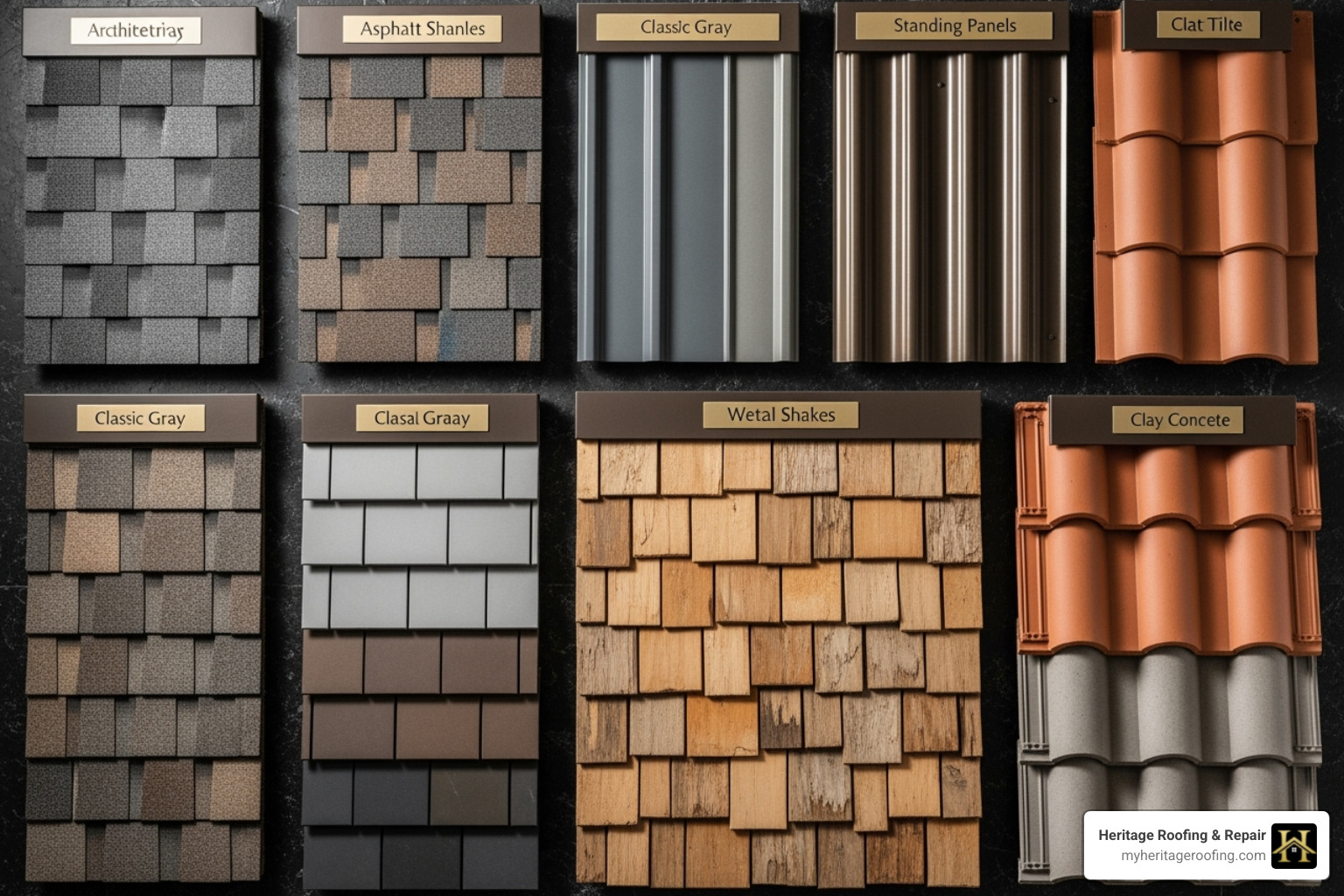
Asphalt Shingles: The Versatile Standard
Asphalt shingles remain the most popular roofing option across North America, and for good reason. They offer a fantastic balance of affordability, versatility, and ease of installation.
- Traditional Asphalt Shingles (Organic): These are the least costly type of shingle on the market, made with a felt or paper mat saturated with asphalt. They are very affordable and available in a wide range of colors. Traditional asphalt shingles are designed to last between 15 and 20 years. However, they are generally less durable than fiberglass shingles and can be flammable.
- Fiberglass Asphalt Shingles: These are built on a fiberglass mat, making them tougher and more resistant. They are known for standing up to harsh wind and hail, and they are fire-resistant. Fiberglass shingles typically last between 15 and 30 years, depending on quality, installation, and climate. While tough, they can become brittle in extreme cold and are more prone to algae growth due to alkaline substances.
Both types of asphalt shingles are relatively easy to repair or replace if a section gets damaged. Their widespread availability and straightforward installation contribute to their cost-effectiveness, making them a go-to for many homeowners.
Metal Roofing: The Durable, Long-Term Solution
Metal roofing has grown significantly in popularity for new residential roofing due to its exceptional durability and longevity. With proper installation and maintenance, a metal roof can last over 50 years, making it a true long-term solution.
Pros of Metal Roofing:
- Extreme Durability: Metal roofing is completely resistant to rot, cracking, insects, mildew, algae, and UV rays. It’s also fireproof, offering excellent protection against various hazards.
- Longevity: Expect a lifespan of 50 years or more. Some types, like copper, can last over 70 years.
- Energy Efficiency: Metal roofs can reflect sunlight, significantly reducing cooling costs by up to 25% in warmer climates like Arkansas.
- Low Maintenance: They require minimal upkeep once installed.
Cons of Metal Roofing:
- Higher Upfront Cost: Metal roofing typically has a higher initial investment compared to asphalt shingles.
- Noise: Rain and hail can be noisier on a metal roof, though this can often be mitigated with additional sheathing or insulation.
- Snow Shedding: In areas with heavy snowfall (like parts of Northern Arkansas), snow can slide off metal roofs in large pieces, posing a hazard to objects or people below.
For homeowners prioritizing a long-lasting, low-maintenance, and energy-efficient roof, metal roofing is an excellent choice.
Wood, Tile, and Slate: Premium and Specialty Options
For those seeking a distinctive aesthetic and superior performance, wood, tile, and slate offer premium new residential roofing options, each with unique characteristics.
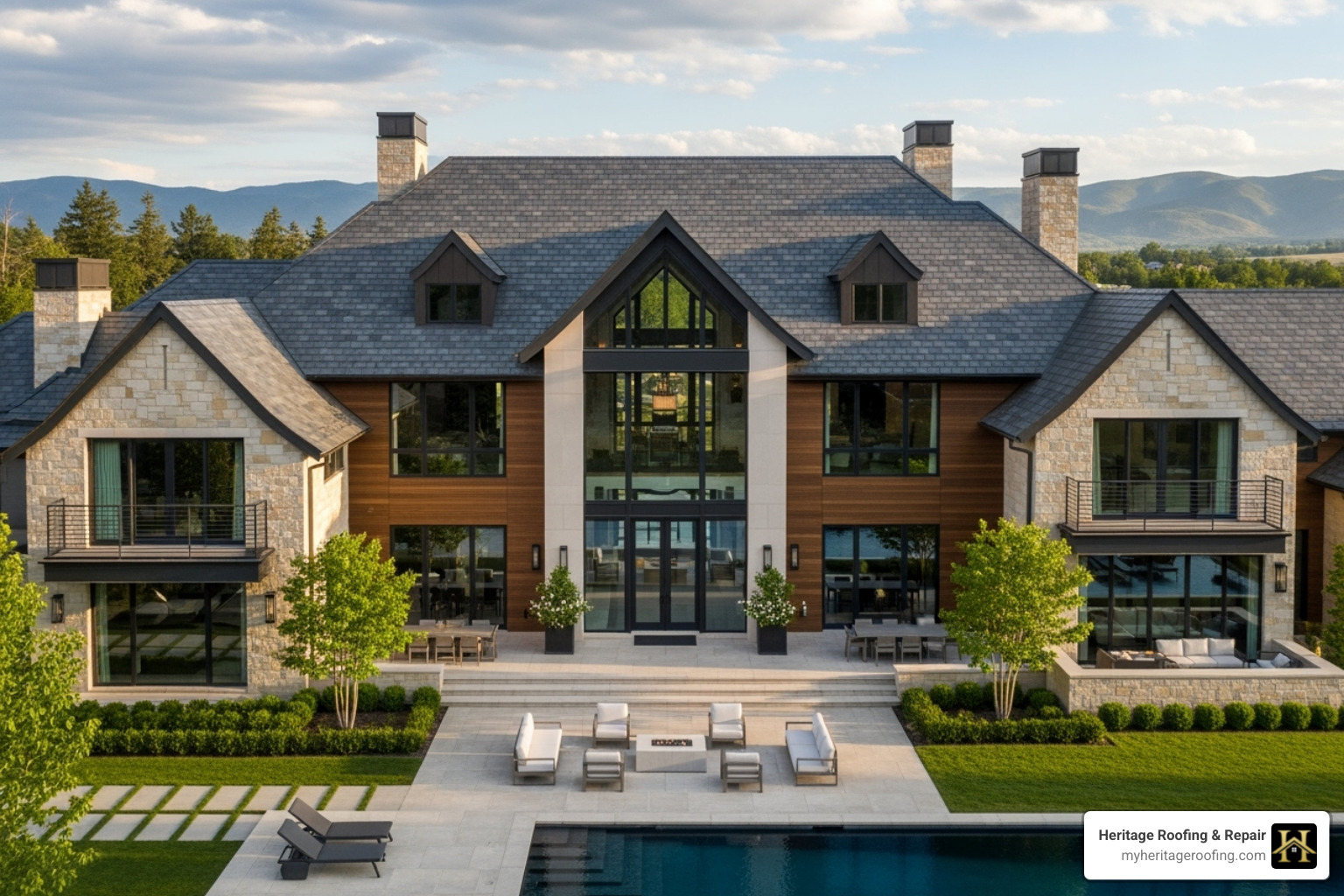
Wood Shingles and Shakes:
Wood shingles and shakes provide a natural, rustic beauty that can complement many architectural styles. They are highly effective in keeping cool air in during the summer and retaining heat during the winter, which can lower energy costs and reduce a home’s carbon footprint. With proper maintenance, wood shingles and shakes can last up to 30 years or more. However, they are considered high-maintenance, requiring regular topcoat upkeep and cleaning to prevent moss and algae growth. They are also costly and, despite treatments, can still be flammable.
Clay and Concrete Tiles:
Tile roofing, whether clay or concrete, offers exceptional durability and a classic look, often associated with Mediterranean or Spanish architectural styles. Clay tile roofs are fire resistant and withstand threats like wind, sun, snow, and hail. Properly installed clay tile roofs by a professional roofing contractor can last over 100 years with routine maintenance. Concrete tiles resist weathering like champs! Cracking or breaking isn’t something you’ll worry about with these on your roof. They are also highly durable and can mimic the look of natural slate or wood. The main consideration for both clay and concrete tiles is their weight. Concrete tiles are heavier than other options, which means extra structural support might be necessary for some roof styles, adding to installation complexity and cost.
Slate Roofing:
Slate roofing is the epitome of luxury and longevity. A well-maintained slate roof has been known to last longer than any other roofing option, often exceeding 100 years. It is completely fireproof and offers unparalleled aesthetic appeal. However, slate comes with significant considerations. Installing slate shingles requires reinforcing the roof to support the immense weight of the stone. While incredibly durable, its rigidity makes it vulnerable to breaking under pressure, meaning careful handling and experienced installers are crucial. As noted in some sources, the Disadvantages of Slate Roofing include its heaviness, easy damage, and high cost. Due to its weight and installation complexities, slate is one of the most expensive roofing materials.
Synthetic & Composite Shingles: The Modern Alternative
Synthetic and composite shingles represent a modern advancement in new residential roofing, offering the aesthetic appeal of natural materials with improved performance. These materials are crafted from a blend of synthetic polymers, recycled materials, and sometimes wood fibers or slate bits.
Benefits of Synthetic & Composite Shingles:
- Durability: Composite shingles can last between 40 and 50 years, while synthetic roofs are expected to last 50 years or more with minimal upkeep. They are designed to resist impact, water, wind, and algae growth, and they are fire resistant.
- Low Maintenance: Unlike natural wood or slate, these materials require very little maintenance.
- Aesthetics: They are engineered to mimic the appearance of natural slate, cedar shakes, or other premium materials, providing a high-end look without the associated drawbacks of natural products.
- Eco-Friendly: Many synthetic roofing materials are made from recycled rubber and plastic, contributing to reduced waste in landfills and offering an environmentally friendly option for homeowners.
Synthetic and composite shingles are an excellent choice for homeowners looking for a durable, aesthetically pleasing, and low-maintenance roof that often comes with an eco-friendly bonus.
Balancing Your New Residential Roofing Project: Aesthetics, Performance, and Budget
Choosing the right new residential roofing material involves a delicate balance between how it looks, how well it performs, and how much it costs. It’s about finding the sweet spot that suits your home, your lifestyle, and your wallet. We believe in helping our clients make informed decisions that offer the best long-term value.
Your home’s curb appeal is significantly impacted by its roof. The material you choose should complement your home’s architectural style and improve its overall aesthetic. But beyond looks, performance is key. How will the roof stand up to Arkansas’s climate? Does it offer the energy efficiency you desire? And finally, the budget. While asphalt shingles are often the most budget-friendly upfront, the long-term value of a metal or composite roof, with its extended lifespan and lower maintenance, might offer a better return on investment over decades. A full roof replacement is a significant upgrade, and we can help you find the right balance.
To help you visualize this balance, here’s a quick comparison of some key roofing materials:
| Material | Cost | Lifespan | Maintenance | Best For |
|---|---|---|---|---|
| Asphalt Shingles | Low | 15-30 years | Low-Medium | Budget-conscious homeowners, traditional aesthetics, ease of repair. |
| Metal Roofing | Medium-High | 50+ years | Low | Long-term investment, energy efficiency, extreme durability, modern aesthetics. |
| Composite Shingles | Medium | 40-50 years | Low | Balancing durability, aesthetics (mimics natural materials), and lower maintenance; eco-conscious choices. |
| Slate Roofing | Very High | 100+ years | Low | Luxury homes, timeless aesthetic, extreme longevity, fire resistance; requires structural reinforcement and specialized installation. |
The average cost for a roof replacement typically ranges from $5,500-$11,000, with an average hovering around $8,314 for most homeowners. This initial investment can be managed through various Roofing Financing Options that can help make your dream roof a reality, ultimately adding to your home’s resale value.
The New Residential Roofing Installation Process in Berryville, AR
When you decide it’s time for a new residential roofing project, partnering with experienced professionals is crucial. A quality roof installation ensures your investment is protected and your home remains safe and sound for years to come. Here at Heritage Roofing & Repair, we pride ourselves on our meticulous process and commitment to excellence.
We serve homeowners across Northwest Arkansas, including our local community in Berryville. You can find us at:
Heritage Roofing & Repair
3458 Arkansas State Hwy 221, Berryville, AR 72616
(870) 654-1164
Step-by-Step Guide to Your New Roof Installation
Our process is designed to be transparent and efficient, ensuring you’re informed and comfortable every step of the way:
- Initial Consultation & Free Estimate: It all starts with a conversation. We’ll discuss your needs, preferences, and budget. Our experienced team will then conduct a thorough assessment of your existing roof (if applicable) and provide you with a detailed, transparent, and specific contract outlining all aspects of the project, from materials to pricing.
- Material Selection: Based on our discussion and your home’s requirements, we’ll help you select the perfect roofing material. We offer a variety of high-quality options from trusted suppliers.
- Scheduling the Project: Once materials are chosen and the contract is finalized, we’ll schedule a convenient time for your installation. We strive for efficiency, often completing residential projects in just a few days.
- Site Preparation: On installation day, our team will protect your property, covering landscaping, driveways, and other vulnerable areas to prevent damage and ensure a clean workspace.
- Tear-off of Old Roof (if applicable): If it’s a replacement, the old roofing materials will be carefully removed and disposed of. This is a crucial step to ensure a clean base for your new roof.
- Decking Inspection and Repair: With the old roof gone, we inspect the roof decking for any signs of damage, rot, or weakness. Any necessary repairs are made to ensure a sturdy foundation for your new roof.
- Installation of Underlayment and Flashing: A protective underlayment is laid over the decking to provide an additional barrier against moisture. Flashing, typically made of metal, is installed around chimneys, skylights, vents, and other penetrations to prevent leaks. This step is vital for ensuring water-tightness.
- Shingle or Panel Installation: The chosen roofing material is then expertly installed according to manufacturer specifications and local building codes. Our skilled crews ensure precise application for optimal performance and aesthetics.
- Site Cleanup: Once the installation is complete, our team conducts a thorough cleanup, removing all debris, nails, and old materials from your property. We leave your home looking pristine.
- Final Inspection: We perform a comprehensive final inspection to ensure every detail meets our high standards of quality and craftsmanship, and that you are completely satisfied with your beautiful new roof.
Frequently Asked Questions about New Residential Roofing
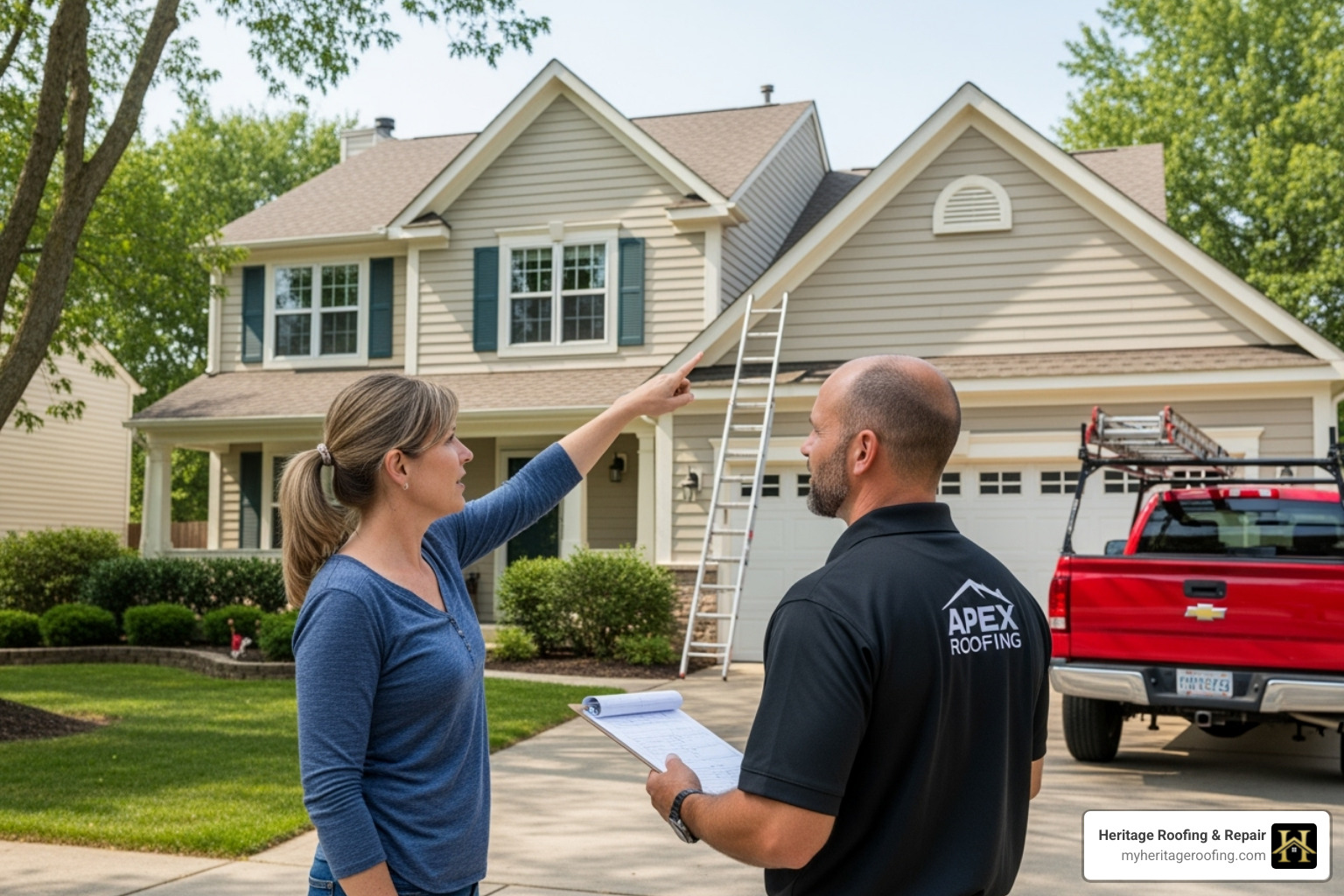
We understand that a new residential roofing project can spark many questions. Here are some of the most common ones we hear from homeowners in Arkansas:
How long does a new roof installation take?
The duration of a new residential roofing installation can vary depending on several factors. Most residential roof installations are completed in as little as two days, but larger or more complex projects might take up to three days. Factors influencing the timeline include the size and pitch of your roof, the complexity of its design (e.g., multiple dormers or valleys), the type of material being installed, and of course, weather conditions. Our professional crews work efficiently to minimize disruption to your daily life, ensuring a swift yet high-quality installation.
How do I choose the right material for my budget?
Choosing the right material for your budget involves more than just the initial price tag. While traditional asphalt shingles are the most budget-friendly upfront, costing significantly less than other options, consider the long-term value. Metal and composite roofs, for example, have a higher initial cost but offer extended lifespans (50+ years for metal, 40-50 years for composite) and often lower maintenance requirements. This means fewer replacements and potentially lower energy bills over time, leading to long-term savings. We encourage homeowners to balance the initial investment with the expected lifespan, maintenance needs, and energy efficiency benefits to determine the true cost-effectiveness for their specific situation. The average roof replacement cost typically ranges from $5,500-$11,000, with an average hovering around $8,314 for most homeowners, so weighing these factors is key.
What kind of warranty should I expect for my new roof?
When investing in new residential roofing, understanding your warranty is crucial for peace of mind. There are generally two types of warranties you should expect:
- Manufacturer’s Warranty: This warranty covers defects in the roofing materials themselves. The duration and coverage can vary significantly by material type and manufacturer. For example, some asphalt shingles might have a 25-year limited warranty, while metal or composite materials could come with 50-year or lifetime warranties.
- Workmanship Warranty: This warranty is provided by the roofing contractor and covers errors in the installation process. This is incredibly important because even the highest quality materials can fail if not installed correctly. Our workmanship warranty reflects our commitment to quality and ensures that any issues arising from our installation will be addressed promptly.
A good Roofing Warranty provides comprehensive coverage for both materials and labor, giving you confidence in your investment for decades to come.
Conclusion: Protecting Your Home with the Right Roof
Choosing a new roof is a major decision that requires balancing cost, durability, aesthetics, and local requirements. By understanding the materials available and partnering with a trusted expert, you can ensure your home is safe, beautiful, and protected for decades. We’ve explored the diverse world of new residential roofing, from the versatile asphalt shingles to the long-lasting metal, and the premium wood, tile, and slate options, as well as the innovative synthetic and composite alternatives. Each material offers unique advantages and considerations, especially when factoring in Arkansas’s climate and building codes.
For homeowners in Arkansas, Heritage Roofing & Repair offers the experience and quality craftsmanship needed for a successful project. With over 50 years of trusted experience, we are dedicated to providing dependable, affordable, and quality craftsmanship for your home. If your home is ready for an upgrade, explore your options for a complete Roof Replacement. We are here to guide you every step of the way, ensuring your new roof is a source of pride and protection for years to come.
